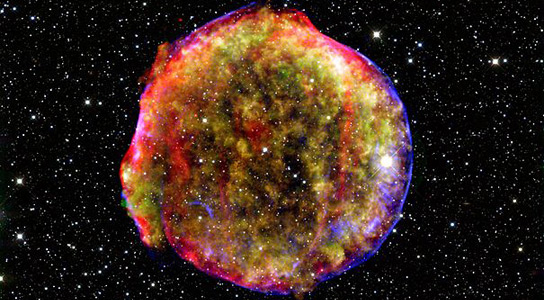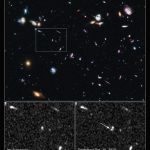SN Primo Is Farthest Type Ia Supernova Discovered
January 16, 2012

Supernova Primo originated 9 billion years ago, when its progenitor star exploded. The light was captured by the Hubble Space Telescope by a three-year project specifically trying to find Type Ia supernovae. These types of supernovae are paramount in order to discover more about the inflationary nature of our universe.
Researchers have been able to verify its distance by redshift and it will help astronomers better understand our inflationary universe, but also the constraints of dark energy. It brings astronomers a step closer to understanding the nature of dark energy which drives the cosmic acceleration states John Grunsfeld, associate administrator for NASA’s Science Mission Directorate in Washington.
 Scientists believe that Type Ia supernovae originate from white dwarf stars that have collected an excess of materials from their companions and subsequently exploded. Due to their remote nature, they have been used to measure great distances with acceptable accuracy. The CANDELS, Cosmic Assembly Near-infrared Deep Extragalactic Legacy Survey, and CLASH, Cluster Lensing and Supernova Survey with Hubble, Supernova Projects aims to create a census, thanks to the versatility of Hubble’s Wide Field Camera 3 so that astronomers can verify their distance with spectroscopy.
Scientists believe that Type Ia supernovae originate from white dwarf stars that have collected an excess of materials from their companions and subsequently exploded. Due to their remote nature, they have been used to measure great distances with acceptable accuracy. The CANDELS, Cosmic Assembly Near-infrared Deep Extragalactic Legacy Survey, and CLASH, Cluster Lensing and Supernova Survey with Hubble, Supernova Projects aims to create a census, thanks to the versatility of Hubble’s Wide Field Camera 3 so that astronomers can verify their distance with spectroscopy.Researchers say that while they’ve exhausted optical light, they’ve only begun in infrared light. It took the research team several months to locate SN Primo’s faint signature. It was first captured in October 2010. Then, the WFC3′s spectrometer needed to validate SN Primo’s distance and analyze the spectra to confirm that it’s a Type Ia supernova. As more of these types of supernovae are studied, if there are variations, it may lead to a way of categorizing these changes and aid in measuring dark energy. Riess and two other astronomers shared the 2011 Nobel Prize in Physics for discovering dark energy 13 years ago and using Type Ia supernova to plot the universe’s expansion rate.
If supernovae take a long time to evolve to a point of explosion, it could take a long time to find Type Ia supernovae. However, if they form quickly, then they’ll be immediately visible, relatively speaking, and there should be many of them in our universe.
No comments:
Post a Comment